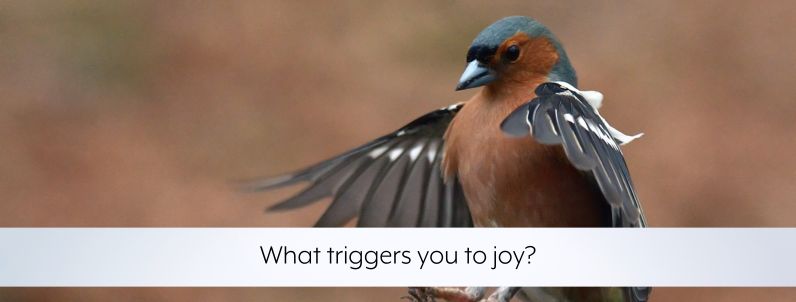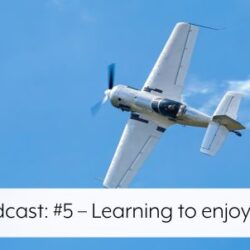
There is a whisper of wind on the trees by the river. The light glints and glances off the green. A male chaffinch lands, all streak of white on its wings, dusky pink chest puffed unprimly out to the world, as if to say, ‘I’m here. My branch. My tree. My rules.’ It hops about, pecks, flutters away, and returns. Its mate swoops in from upstream, brownish drab. A robin – red-breasted, none of this understatement of dusky pink – trills into song from a nearby bush, piercingly and unfeasibly loud. Off to my left, hidden somewhere up high in the early greenery of a hawthorn bush, are the insistent, busy squeaks of long-tailed tits.
I suddenly realise that I have become caught up, flow-like, in the drama of nature. I’m not entirely sure how much time has passed, but I do know that everything I’ve been stressed about lately ceased, for that little while, to be. I feel a thrill of joy – a soft, sparkling sense, a humming pleasure. Nothing big, nothing grand, nothing overpowering. Not a klaxon announcing, ‘JOY’. Just a mild sprinkling of momentary delight. I was ‘triggered’ into a positive state.
We know what it’s like to be triggered by negative events. But are we mindful of what triggers joy in us?
After trauma, the brain is geared towards danger. Of course it is. It’s trying to keep us alive. It knows that the world is dangerous, that bad things happen, and it’s on the look-out for them. So our attention is subtly drawn, constantly, unerringly, unconsciously to the negative. We store within us a long notation of potential dangers, ‘triggers’, associations with threat from the past – designed to tip us off ahead of time, to warn us of impending disaster, so that we are ready to react.
Yes: as trauma survivors, we all know what it is to be triggered. But triggers aren’t all negative. That is only half of the ‘approach-avoidance’ dynamic which unconsciously drives so much of our behaviour. Of course we avoid danger, and trauma triggers provide for us a smorgasbord of potential associations. But we are also wired, although more subtly so, to ‘approach’. We are wired, although more subtly so, for joy.
After trauma, we have to work hard to develop this sense: it has been smothered under the clamour and the chaos of danger, drowned out by the ceaseless scream of blues-and-twos. The orientation to joy is present in quick-to-smile children: wonder, curiosity, and the inevitable finger-mushing of spaghetti for the pure pleasure of discovery and novel textures. But it’s a drive that is easily lost when our brain becomes convinced that the world is unendingly dangerous and we don’t even have the right to be in it.
Part of my journey towards recovery has been to retrain my brain to notice joy. Not as an ‘either/or’, an ‘either I’m traumatised or I’m not’ kind of thing. Not as a way to disown and suppress the distress that I’m feeling, the danger I’m experiencing, or the reality of my situation. But alongside it. My brain is capable of more than one response, and sometimes even at the same time. So I’ve had to train my brain to notice joy. I’ve had to become sensitive to triggers of happiness and warm my brain to notice them. Threat clamours loud with volume and sensationalism. Joy is subtle: an acquired taste.
I am triggered to joy by the gleeful sprint of my dog on the beach, a white bottom bobbing shamelessly up and down; her fearless, reckless scamper over the sand into the shallows; the wind blowing through her beard to pin back her ears; all of her alive in pleasure and freedom and joy. Then when I’ve been away, and I return, her exultant, exuberant welcome – ‘Me, me, pick me!’ – bouncing on her back legs, jumping like a furry little human, rolling at my feet to present her belly, all adoration and bliss.
I am triggered to joy when I’m wandering through nature: when the leaves are just budding in spring, promising to unfurl in a blink. Beautiful, wispy strands of honeysuckle unfolding down a tree-trunk. The ochres and russets in rock formations and all the billions of years of story contained therein. Frost in a spider’s web. The sun setting across the hills throwing scuddy red clouds across the skies. Petrichor – the smell of the earth after rain. Intricate, impossible detail in the fungi and lichen on bark.
I am triggered to joy when I’m learning: the first time a sentence in Spanish comes naturally; when two ideas collide in my mind and create a third; that moment when my brain retracts like a bow with the bigness and scale, the complexity and beauty, of the universe.
I am triggered to joy by the curve of the bridge, the artisanal ironwork from two centuries ago, which someone took the time to create even though it is mostly hidden from sight. The warm hug of the sun on sandstone, the grandeur and symmetry of Georgian architecture riding high up to the sky. The beauty of words well constructed, with wit and craft, with assonance and consonance and tone and voice and aspect and character.
I am triggered to joy by the smell from the log burner; by a powerful shower; by thick paper to write on; by fresh bedding; by the aroma of a new book; by the feel of freshly groomed fur; by the patter of rain on glass.
When we train our brain to notice the detail of the here-and-now, we’re bringing online the medial prefrontal cortex, what I simplifyingly refer to as the ‘front middle brain’. It’s the part of the brain most exercised in mindfulness. It allows us to look inside, to notice our inner sensations. And – perhaps of most relevance to those of us as trauma survivors – it has a thick bundle of connections to the fear centre of the brain: the amygdala. When we notice, when we’re curious, when we focus our attention on the chaffinch or on our own breath, the medial prefrontal cortex dials down our fear responses. By noticing joy, we become, over time, less sensitive to threat. By noticing what is, we become less attuned to the anxiety and the dread of what might be.
After trauma, we live with a thousand triggers of threat. But what about the million potential triggers of joy? Where are they? What are they? Do you notice them?



6 Comments
You have a gift for writing and expression. A client mentioned just today how the sound of the birds was like an aural meditation bringing them to the present and then I read this!
Reading this article was a trigger for joy for me 🙂
Tiffany, I could not agree more! Thank you for such beautiful words Carolyn.
Such an important and underrated skill and one worth cultivating! I found this v helpful and passed it onto my daughter, who has been affected by emotional dis-regularity. Now, she is on the right medication and is fully aware of and has the skills to be able to control her ‘triggers’ but this will definitely add a string to her bow!
Joy Triggers !!! I admit to approaching this article with some trepidation….What if it was a lure to entice an unwary reader into reading something not joyful?
Yet…Having watched your webinars and experienced a powerful resonance with your words, my gut instinct knew better. What a joy your article is. It is now recommended reading for my friends, clients and students.
Thank you for reminding us that there is much to be joyful about in the world and that our joy triggers can often be the simplest of things.
Thank you for such a beautifully written reminder … Trigger JOY!
It has been a life long struggle however perhaps I too deserve to feel joy ?